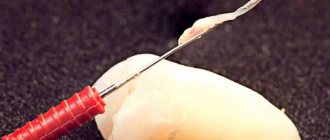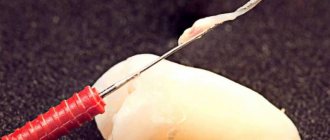In dental practice, there are often cases of advanced caries when a patient comes with complaints of acute toothache. If a doctor diagnoses pulpitis, then one of the stages of its treatment will be the installation of a temporary filling. It protects the canal from food and bacteria entering it. It should cover the exposed area of the tooth until treatment is completed by filling the canals and installing a permanent filling. In addition, the “temporary solution” is also relevant for a number of other pathologies.
Normally, the temporary “protection” is removed by the dentist. But there are situations when it falls out on its own. Why? Various factors can provoke this. But no matter what causes the temporary filling to fall out, it is important to know what to do in this situation and how to prevent complications from developing. After all, the consequences can be very unpleasant - from the spread of infection to the loss of a unit.
When is a temporary filling needed?
When a patient with caries comes to the dentist complaining of tooth pain, it is important for the doctor to assess how deeply the unit is affected and whether the roots and canals are affected. To do this, he sets up a “temporary station” for 2-3 days. If the nerve endings are damaged and a permanent filling is placed, the patient will again experience toothache and will have to have the tooth re-treated. A temporary filling will avoid unnecessary costs and stress.
The dentist decides to install temporary filling material if he diagnoses the patient with:
- deep caries;
- pulpitis;
- periodontitis;
- granuloma;
- tooth cyst;
- abscess.
Such dental manipulation is relevant if it is impossible to treat a tooth in one visit or you need to first relieve the inflammatory process. The doctor also places such a filling while the stump inlays or prostheses are being made in the laboratory.
Do-it-yourself tooth filling
Contraindications and benefits
Before filling a damaged tooth yourself, it is important to determine whether in this case it would be better to entrust the process to a professional. So, you can’t put a filling at home :
- if you cannot get rid of pain;
- the resulting cavity is small in size;
- caries is highly developed, the dental canal is damaged;
- there is a cyst, abscess or other soft tissue disease or pulpitis has developed.
If there is no pain and the caries damage is small, then it is quite appropriate to be interested in how to fill such a tooth at home. One cannot help but appreciate the obvious advantages of this approach:
- Saving money and time. A do-it-yourself filling will cost several times less than one installed by a dentist. There is no need to leave home and stand in line.
- Tooth rescue. Dentists are often inclined to take drastic measures, but self-treatment can help save the tooth.
- Protection against infection. When treating a tooth at home, you can be sure that all instruments used are sterile. It is impossible to check how instruments are treated in the dentist’s office after repeated use.
- No stress. A trip to the dentist causes some people to panic; some even faint at the sight of a drill. In this case, home filling is a good alternative.
How long is it temporary?
The period for installing such a filling depends on the purpose and clinical situation. It can range from 3 days to several months. If the doctor uses arsenic-based paste, then further treatment is carried out after 3-5 days, a maximum of a week. You cannot walk with arsenic in your tooth for any longer, as it can not only kill the nerve, but also destroy healthy tissue.
If the material used is necessary to protect against food and bacteria getting inside the canals during their sanitation or treatment of inflammation, it can remain in the tooth for several weeks. For longer treatments, the dentist may replace temporary fillings if a new dose of medication becomes necessary.
How long should arsenic remain in a tooth?
Installing arsenic takes a little time. The dentist performs the following actions:
- pulp opening;
- removal of damaged dentin;
- laying the paste;
- providing sealing using artificial dentin.
Previously, the substance was placed with a closed pulp, but now this practice is not used, as there is a possibility of pain and swelling. Arsenic, depending on which tooth is being treated, is set for the following period of time:
- single-rooted – 24 hours;
- the rest – 48 hours.
It is very important to visit a doctor on the day of your appointment, as prolonged exposure to the substance becomes dangerous.
Read also: What is topical anesthesia in dentistry?
A temporary filling over arsenic has fallen out - you need to see a doctor urgently
Arsenic should not be kept for more than 62 hours.
There are substances that can be kept for up to two weeks, these include depulpin. It is necessary to clarify with a specialist which particular drug was used. If it is not possible to visit the dentist at the appointed time, you need to extract the substance yourself. You need to be very careful with arsenic so that it does not enter the gastrointestinal tract when extracted. You need to remove it yourself for certain reasons.
What causes a temporary filling to fall out?
A patient may have a temporary filling fall out due to medical negligence:
- if the doctor did not properly dry the tooth cavity after pre-treatment or saliva got there before applying the filling material;
- if, after cleaning the carious cavity, particles of infected tissue remain;
- if the surface is not processed well enough, which will cause the enamel to destroy the material;
- if the filling is placed on a pulpless tooth, in this case it cannot hold tightly, because the surface of the unit is fragile, nutrients do not reach it;
- if low-quality or expired materials were used to create a temporary filling;
- if the tooth is severely affected by caries and the filling does not have the necessary support.
But not only the doctor can be the culprit of the problem. A temporary filling falls out when the patient does not adhere to the recommendations received after dental procedures. For example, he decides to have a snack immediately after leaving the doctor's office. Despite the fact that you need to refrain from eating for 1-2 hours. In addition, the filling may fall out if there is a large load on it (when chewing nuts and candies, opening bottles with teeth, biting thread, etc.). Its gradual loosening is provoked by chewing gum and toffee candies, toffees.
Is it possible to remove caries at home?
Today we can confidently answer this question – yes. Initial carious lesions of tooth enamel can be stopped and even cured at home. Filling and removal are inevitable methods when caries has already penetrated under the enamel and reached the dental tissues, bones, and roots. But as long as the process develops on the surface of the enamel, it can be reversed.
Early stage caries can be cured at home
This is interesting. According to the research of the American doctor Price, who spent a long time studying the condition of the teeth of the indigenous peoples inhabiting the continent, it was found that, despite the lack of oral hygiene, these people did not suffer from caries. The doctor began to feed the subjects “Western” food that had undergone heat treatment and did not contain enough vitamins. Their teeth began to deteriorate as rapidly as those of the new Westerners.
Seven steps to getting rid of caries at home
A beautiful smile is the key to proper oral care
Step one
Limit or completely eliminate foods containing large amounts of phytic acid. This acid is the main chemical form in which phosphorus is found in foods. Its excess is found in traditionally healthy products known as suppliers of vegetable protein and fiber - grains, oilseeds, nuts, legumes.
Table of phytic acid content in foods
What happens when the body is oversaturated with phytic acid? Proper absorption of phosphorus is inhibited. This component also binds and stops absorbing calcium, zinc, iron and magnesium. These bound forms, called phytates, change the composition of the blood, making it less mineralized. To get the necessary minerals, the body begins to pull them from the dental and bone tissue. This leads to weakened teeth, which are easily affected by caries.
Phytic acid leads to tooth decay
Step two
You can call it remineralization. The goal is to quickly restore the lack of minerals in dental tissue. This is done by saturating the enamel from the outside, using toothpaste containing fluoride and a mouthwash that matches it in composition.
Parodontax toothpaste
In parallel with using fluoride-containing paste during the day, it is recommended to rinse your mouth with aqueous solutions of calcium and magnesium powders. This will not only saturate the enamel with minerals, but will also maintain an alkaline environment in the oral cavity, neutralizing the acidity that contributes to the occurrence of caries.
Use the mouthwash 2 times a day
Advice. Before you start using fluoridated toothpaste, check the drinking water chemistry in your area. If the water has a high fluoride content, its excess can pose a danger to the body, leading to hypervitaminosis.
Step three
Improve the quality of food. Give up processed foods and fast food in favor of healthy foods. Eat more vegetables. Do not overcook foods.
- Caries in the spot stage
Delicious and healthy vegetable salad
Step four
Take supplements. From food, no matter how fortified, mineralized, natural and organic it is, modern man cannot get all the nutrients he needs. This doesn't mean you can give up healthy foods. This only means that to help the body and saturate it with useful substances, you need to take vitamins and minerals in the form of supplements.
Ascorbinka
Fermented fish oil, vitamin D, ascorbic acid, calcium, magnesium - all this is no worse absorbed by the body from small tablets and capsules than from kilograms of food that you will have to digest to replenish the vitamin-mineral complex.
Fermented fish oil
Step five
Eat foods that restore teeth. Meat from organically raised animals, offal, seafood, natural fats and dairy products (we are not talking about powdered milk and synthetic cottage cheese). Vegetables, herbs, vegetable fats. All this will help restore the protection of teeth from caries.
Natural dairy products for dental health
Step six
Hygiene. Although Native Americans did not practice oral hygiene, modern people cannot do without it. Hygienic procedures must be carried out in the prescribed manner and according to a specific protocol. Fighting bacteria and keeping your mouth clean will significantly reduce the chances of tooth decay.
Oral hygiene
Step seven
Don't tolerate toothache, even if it doesn't bother you much.
- Apply rinses with salt (sea) water or soda solution.
- Place a drop of clove oil on a cotton swab and apply it to the sore spot.
Clove oil
- Apply the mummy to the tooth.
- Take Ibuprofen or take the painkiller you usually take in such situations.
Ibuprofen
- If the pain continues, go to the doctor.
How can you tell if a filling is about to fall out?
After filling, the material occupies the entire drilled cavity; there are no gaps between it and the tooth tissues. When gaps appear between the filling and the tooth, it wobbles when pressed with the tongue, and you need to consult a doctor to prevent the material from falling out.
If this has already happened, and the patient notices a hole in the problem tooth, you need to act consciously. You cannot seal it with chewing gum or insert cotton wool or other improvised materials into the cavity. It will not be possible to seal the hole hermetically; such measures can only do harm, because this will create favorable conditions for the proliferation of pathogenic microorganisms and the spread of infection.
Dental filling from Acrodent
The dental product Acrodent is used to install a permanent filling after introducing the disinfectant drug Santedex into the cavity. To carry out the procedure you should prepare:
- special dental spatulas;
- cotton wool;
- regular hair dryer;
- Chlorhexidine.
To carry out filling at home with Acrodent, you must perform the following steps:
- Clean your mouth with a toothbrush and hygienic paste.
- Treat the tooth with a cotton swab dipped in disinfectant liquid.
- Dry the filling area with a household hairdryer.
- Apply the oxidizing agent from the package into the tooth cavity and dry the hole again.
- Place small pieces of cotton wool around the tooth.
- Prepare a medicinal mixture of dough-like consistency based on powder and oxidizing agent from Acrodent.
- Fill the bottom of the hole with a small amount of the resulting mixture using a dental spatula.
- Apply several layers of this preparation, drying each one.
It is recommended to install a homemade filling to the bottom of the tooth hole and fill the cavity completely, but not above the level of the tooth surface. This will help prevent the formation of discomfort in the oral cavity. If there is a large hole, two fillings should be made.
What to do?
Of course, you need to see a dentist. But the patient does not always have the opportunity to urgently leave work. In addition, many people believe that there is nothing wrong with a filling falling out and are in no hurry to visit the dentist.
When the doctor places a filling, he notifies the patient about what materials are used and for how long it is installed. It is important to remember this, because if the doctor used arsenic-based paste to kill the nerves, then one should not hesitate in case of material loss. This substance is poisonous! If it gets on the mucous membrane, it causes a burn, and if swallowed, it causes poisoning, gastrointestinal upset, and the development of an allergic reaction.
Therefore, if the patient notices a hole in the tooth, he needs to thoroughly rinse the oral cavity with a soda solution (dissolve 1 teaspoon of soda in 1 glass of warm boiled water and add a few drops of iodine). After this, you need to cover the hole with a sterile gauze swab and go to the doctor.
If the dentist filled the canals and installed a temporary filling, but it fell out, this is not so dangerous. After all, there is no toxic substance inside the tooth and infection will no longer penetrate into the canals. But you still need to visit a dentist to solve the problem. The doctor will conduct an examination and decide what to do - put a temporary filling again or replace it with a permanent one.
We recommend remembering the following algorithm of actions:
- If the filling falls out while eating, it is better to spit out the chewed food. After this, you need to rinse your mouth with an antiseptic (Chlorhexidine, Miramistin) or a soda solution. If you don't have this on hand, you can use mouthwash or clean water.
- You should not try to close the hole with chewing gum or other improvised means, or pick out the remnants of the filling material. There is a risk of damaging the mucous membrane or leaving a piece of the used “tool” in the hole, which will provoke the development of the inflammatory process. Do not try to insert a painkiller or antibiotic tablet into the hole. It won't help.
- Before eating, it is necessary to cover the damaged unit with a sterile gauze pad and minimize the load on this side of the jaw. Be sure to rinse your mouth thoroughly after every meal.
- If pain bothers you, you can take a non-steroidal anti-inflammatory drug, for example, Nurofen, Trialgin, Ketanov, etc. The recommended duration of taking these medications without medical supervision is no more than 3 days.
- As a result, in any case, you need to make an appointment with the dentist and have your tooth treated.
It should be remembered that you should not put off visiting a doctor until later. This is fraught with the development of an inflammatory process and may lead to the need to remove the unit.
Why is arsenic needed in dental treatment?
The limit varies from 5 to 50 mg depending on the weight parameters and sensitivity of the patient. Nowadays they use not arsenic, but a paste based on it containing:
- 1/3 of the paste is arsenic anhydride;
- less than 1/3 of the composition is a substance for accelerated pain relief;
- 5% camphor or thymol to eliminate microflora and sterility of the pulp;
- only 1% tannin - to extend the effect of the drug to 2 days, since this substance can slow down the process of diffusion of arsenic into the pulp tissue.
Read also: Crooked teeth in children
Filling falling out during pregnancy
If a temporary filling falls out in a pregnant woman, it is also important to consult a specialist. If at the time of treatment she is in her third trimester, and a complex dental procedure is ahead, the doctor can install a new “temporary” and transfer the therapy to the postpartum period.
It is worth remembering that pregnancy is not a contraindication for visiting the dentist. On the contrary, it is better to visit this doctor more often to prevent the progression of caries. After all, this is a collection of microbes that can spread throughout the body and cause harm to health.
How to relieve pain?
If you followed all the doctor’s recommendations, but the tooth under the temporary filling hurts again, the following tips may help you:
- avoid contact of food and drinks, especially very hot or cold ones, on the side of the diseased tooth;
- periodically rinse your mouth with soothing infusions of sage, chamomile and mint and a disinfectant solution of salt and soda;
- Inspect the soft tissue surrounding the tooth as often as possible in order to identify the possible onset of an inflammatory process or suppuration. At the slightest hint of swelling or redness of the gums, call your dentist immediately;
- a cotton wool soaked in tincture of valerian and lemon balm and applied to a sore tooth will help temporarily relieve irritation and soothe pain;
- There are also special preparations (drops, gels) designed to relieve toothache, however, before using them, you should consult a specialist.
If your dentist feels there is no cause for concern, try to endure the painful period so as not to interrupt the treatment process. Unfortunately, any inflammatory process is accompanied by unpleasant sensations. It’s better to have pain under a temporary filling than to have to redo a permanent one later.
Prevention of temporary filling falling out
After the performed manipulations, the doctor always tells the patient what can and cannot be done after he leaves the office. And you need to follow these recommendations.
- You should not eat for 2 hours after filling. At this time, the material hardens.
- During the entire period while the temporary filling is in place, you must not chew nuts and other hard foods, eat chewing candies and other sticky sweets, or use chewing gum.
- It is recommended to minimize the load on the problematic tooth.
- Do not use a waterpik, toothpicks or dental floss to clean a temporary filling. The optimal hygiene product is a soft brush.
It is recommended to inspect the filling daily so that if defects appear, you can detect them in a timely manner and contact your dentist.
Why does a filling fall out?
Fillings fall out for a variety of reasons. This includes service life, the quality of the material, improper dental care, and so on. The most common factors for the destruction of a filling can be:
- Low quality material was used, which quickly shrunk. Because of this, a gap has formed between part of the tooth and the filling. What provoked secondary caries, which manifested itself as pain.
- Improper treatment of the dental cavity for filling.
- Incorrect treatment tactics. When the degree of tooth destruction was not taken into account and restoration was carried out only with filling material without additional supports, which caused the filling to fall out (and often break off the walls of the tooth or its complete loss).
- The natural service life of the filling material has expired (on average seven years).
- The sealed tooth was subjected to excessive stress: nuts, crackers and other hard foods were chewed on it.
It happens that the individual characteristics of the body make the patient’s teeth fragile. This property of dental tissue can be congenital, age-related, or a consequence of certain diseases. In this case, the patient will have to change fillings more often to keep his smile healthy.
Possible complications
When a temporary filling falls out, not all patients immediately consult a doctor. Some people don’t rush to the doctor until the tooth starts to hurt. And in vain, since the consequences can be extremely negative:
- spread of the inflammatory process due to the penetration of pathogenic microorganisms, which will require longer treatment;
- chipping of the crown, which will lead to the need for additional strengthening of the tooth;
- injury to the mucous membrane of the cheeks and tongue and, as a result, pain;
- the need to remove the unit.
How long does it take to walk with a hole? It's up to the patient to decide. But any dentist will tell you that you need to come for an appointment as soon as possible.
| Author of the article: | Gasparyan Eliza Arturovna |
| Speciality: | Dentist-therapist, dentist-endodontist |
| Experience: | 10 years |
Make an appointment











